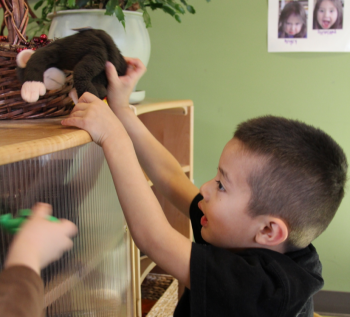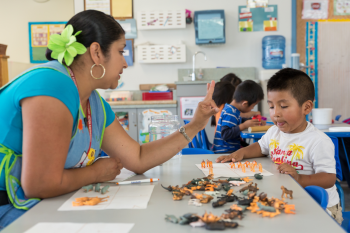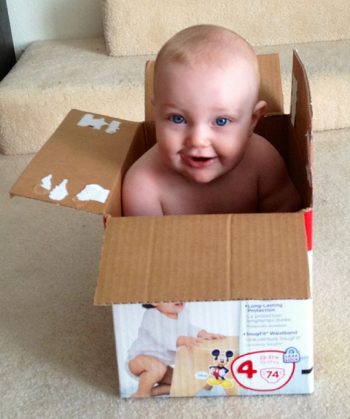3-4 Brains and Bodies
A – Brains and Bodies
Cognition
Perceptual and motor development strongly affects development in other areas, such as cognition and social-emotional development.
Development doesn’t happen in a vacuum, and, as mentioned earlier, motor development in particular is constrained by elements like the body in which it develops (embodied).
What scientists have recently begun to notice though, is how connected our cognition is to our physical and perceptual experiences.
Earlier in this lesson, we talked about sensitive periods during which experiences make a notable difference in how our development progresses. For example, if you don’t:
- Hear language, you don’t learn language.
- See patterns as an infant, it’s hard to see faces later in life.
- See objects or colors, you don’t know what they are later.
But there is much more to this connection. How we receive information and respond to it is greatly affected by our early motor experiences and development.
Scientists have even found that children’s fine motor skills are better predictors of later math and reading scores than early math and reading scores alone.
The Zero to Three article (an assigned reading for this lesson) is a resource on how motor development is important to all areas of development. It covers some common questions (and answers) as well as ideas for activities to get children moving.
The Scientific Learning Blog (another assigned reading for this lesson) is a resource on the connection between motor development and areas of school readiness.
Plasticity
We’ve already mentioned one way that experiences can affect cognition: plasticity.
Plasticity is a description of how one can change their brain architecture and their cognition through experiences.
For example, even as adults we can:
- Distinguish the faces of people of other races if we practice.
- Hear and even understand new languages if we practice them.
Infants and children are even more plastic than adults are, meaning that experiences can greatly change how they see the world.
Earlier, we discussed the concept of perceptual narrowing, where experiences shape children’s understandings of the world in ways that help them specialize their learning to their own environment and culture. What we didn’t discuss is how that perceptual narrowing can be reversed through practice and exposure.
Scientists showed this by exposing 9-month-old, English-speaking infants to Mandarin Chinese-speaking adults. Through normal development, these infants would lose the ability to discriminate Mandarin Chinese sounds between 6 months and 1 year. But with only 12 sessions of exposure to a live Mandarin Chinese-speaking adult, these
infants retained the ability to discriminate sounds in Mandarin Chinese.
Similar results have been found for other perceptual experiences, such as face recognition.
B – Experiences
First-Hand Experiences

Scientists have found that some motor and perceptual experiences accelerate cognitive development.
In the typical course of development, 3-month-old infants have not yet begun to perceive adults’ reaching and grasping actions as goal-directed. In other words, if an adult reaches and grabs a teddy bear, are they trying to grab the teddy bear (goal-directed), or are they just moving their arm in that general area? Three-month-olds do not seem to understand the intention of picking up the teddy bear.
As an adult, if you watch someone pick the teddy bear over the cup multiple times, the next time they reach for something you’ll be surprised if they reach for the cup rather than the teddy bear. But infants younger than 3 months don’t find this surprising at all. They don’t seem to realize that when people reach, they are usually reaching for a specific object and usually for a reason (i.e., because they like that object better).
However, scientists gave 3-month-olds reaching and grasping experiences that they did not encounter naturally by providing them with sticky mittens. These mittens were covered in hook-and-loop fabric. Scientists also gave the infants toys to pick up and manipulate. So these infants were able to reach for and pick up objects in a way that they would not naturally have been able to without the mittens.
After this experience, infants perceived adults’ actions with similar mittens as goal-directed actions. This meant that infants would now expect adults with these mittens to reach consistently for one object over another.
This suggests that even limited first-hand experience can enhance infants’ own understanding of others’ actions in the world.
Video: Sticky Mittens (0:59)
You may be curious about what the sticky mittens training looks like. We will now watch a 1-minute video of an infant wearing sticky mittens.
You’ll see that it’s a simple intervention despite its powerful effects. Infants don’t all of a sudden start intentionally moving objects around the way an adult would, but the information they gain still has strong effects on the way they perceive the world.
Note that this video has subtitles but no sound.
Watch Sticky Mittens from Kennedy Krieger Institute on YouTube.
Culture and Cognition

Culture can also have effects on how children process cognitive information.
For example, when children are in cultures that read from left-to-right, they appear to have a linear spatial arrangement in mind that proceeds from left to right. Evidence supports this idea. When preschoolers were asked to count with their hands, they predominantly counted from left to right spatially.
Another example is math learning studies where children were taught counting and other math skills using a board game. If the board game was arranged linearly, children learned much more than if the board game was arranged in a circle.
It is important to remember that this is specific to the culture in which children are learning. If in children’s culture, counting is presented in a circular fashion or reading and writing proceed from right-to-left, children’s learning will be affected differently.
Some cognitive abilities directly link to spatial arrangements or body positions. Congruence between these relations and how adults teach or present information can help improve children’s learning.
Motor Experiences and Cognition

In an even more direct connection between motor development and cognition, researchers tested 8-month-old infants on an object search task.
Researchers hid objects in containers and then rotated either the infant or the containers 180 degrees. Some of the infants were already crawling while others were not yet.
Scientists found that infants with more crawling experience were better at remembering object locations and finding hidden objects, especially if the infant was disoriented during the task by being turned 180 degrees.
Motor experiences can help infants develop new cognitive abilities, such as searching for hidden objects.
 References
References
Bai, D., & Bertenthal, B. (1992). Locomotor status and the development of spatial search skills. Child Development, 63(1), 215–226.
Grissmer, D., Grimm, K., Aiyer, S., Murrah, W., & Steele, J. (2010). Fine motor skills and early comprehension of the world: Two new school readiness indicators. Developmental Psychology, 46(5),1008–1017.
Kennedy Krieger Institute. (2011, September 7). Sticky mittens. [Video]
Kuhl, P., Tsao, F., & Liu, H. (2003). Foreign-language experience in infancy: Effects of short-term exposure and social interaction on phonetic learning. Proceedings of the National Academy of Sciences of the United States of America,
100(15), 9096–9101.
McCune T. (2012, March 6). Jack-in-the-box. [Photo]
Patro, K., Nuerk, H.-C., & Cress, U. (2015) Does your body count? Embodied influences on the preferred counting direction of preschoolers, Journal of Cognitive Psychology, 27(4), 413-425.
Siegler, R. S., & Ramani, G. B. (2009). Playing linear number board games—but not circular ones—improves low-income preschoolers’ numerical understanding. Journal of Educational Psychology, 101(3), 545–560. [Journal Article]
Sommerville, J. A., Woodward, A. L., & Needham, A. (2005). Action experience alters 3-month-old infants’ perception of others’ actions. Cognition, 96(1), B1–B11.
The Scientific Learning Blog. (2012). Exploring the connection between motor skills & cognition. [Blog Article]
Zero to Three. (2004). On the move: The power of movement in your child’s first three years [0-36 months]. [PDF]
EarlyEdU Alliance (Publisher). (2018). 3-4 Brains and bodies. In Child Development: Brain Building Course Book. University of Washington. [UW Pressbooks]

